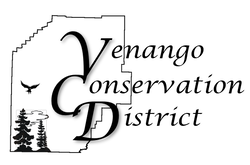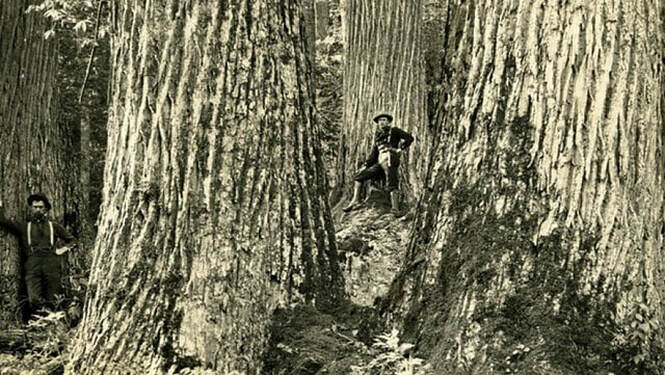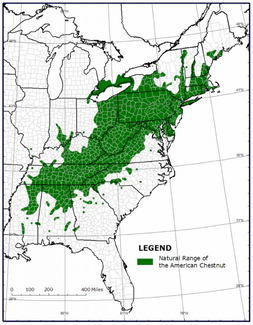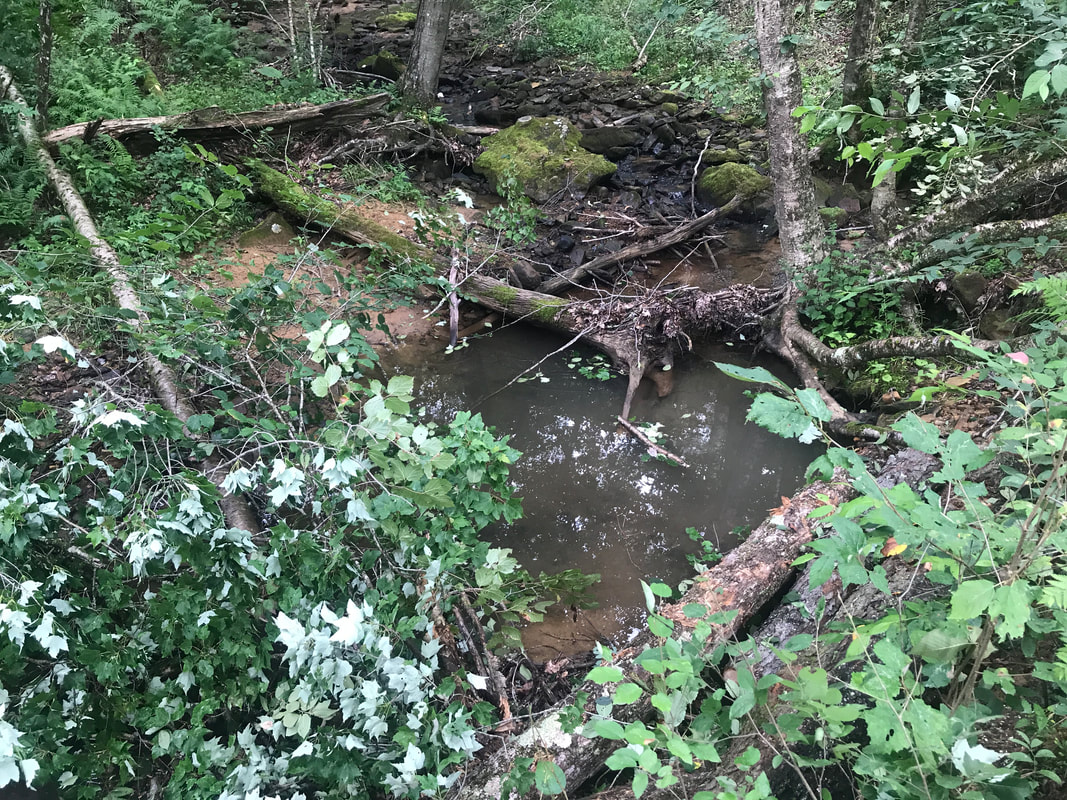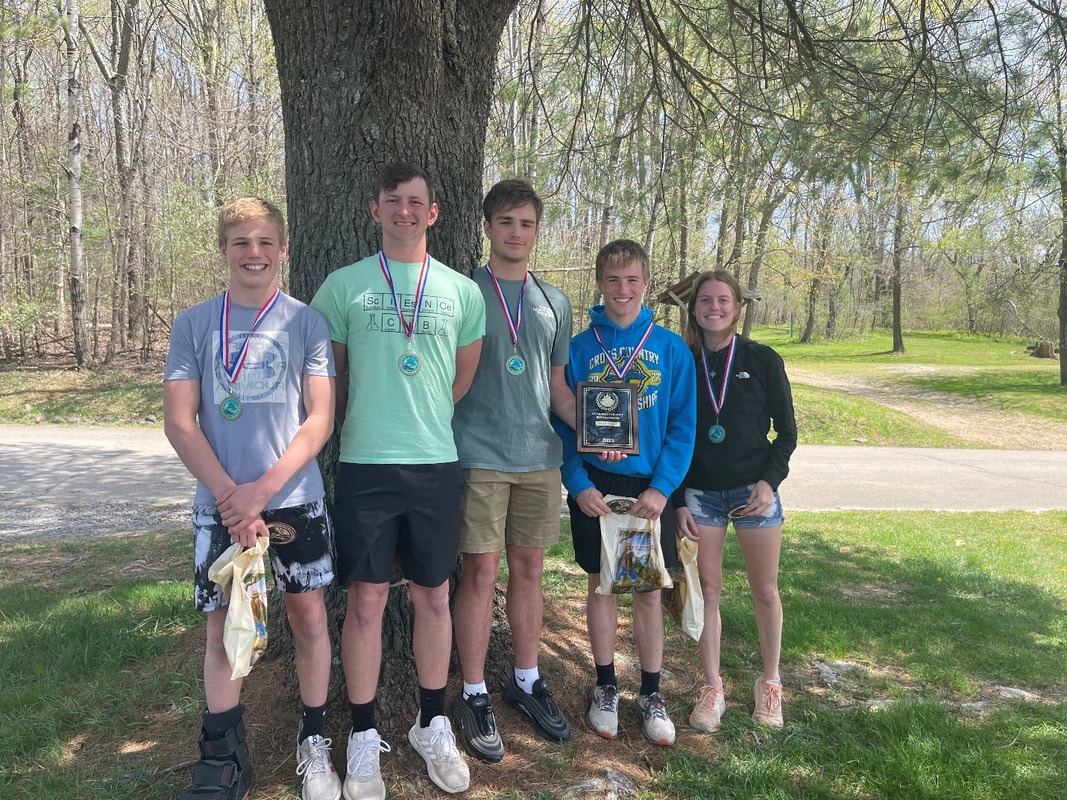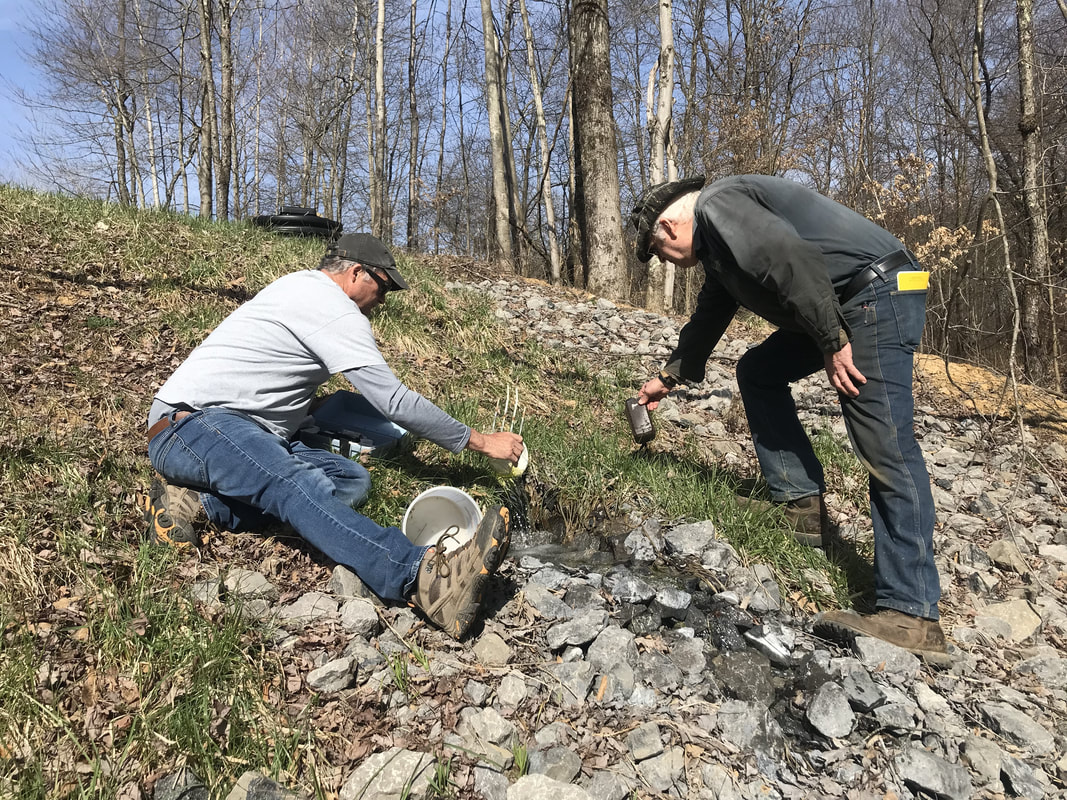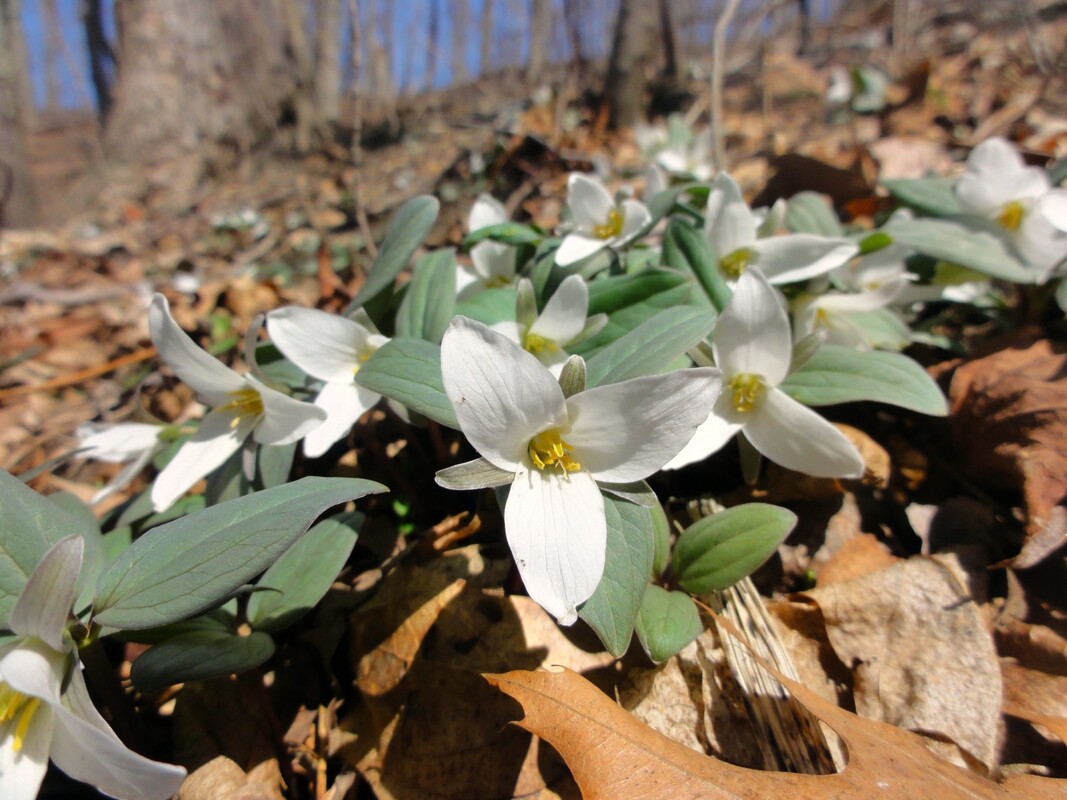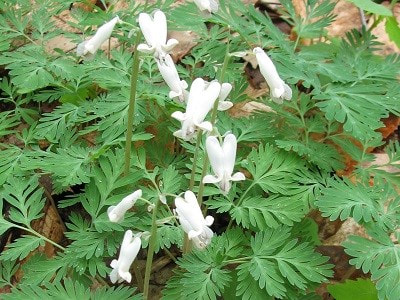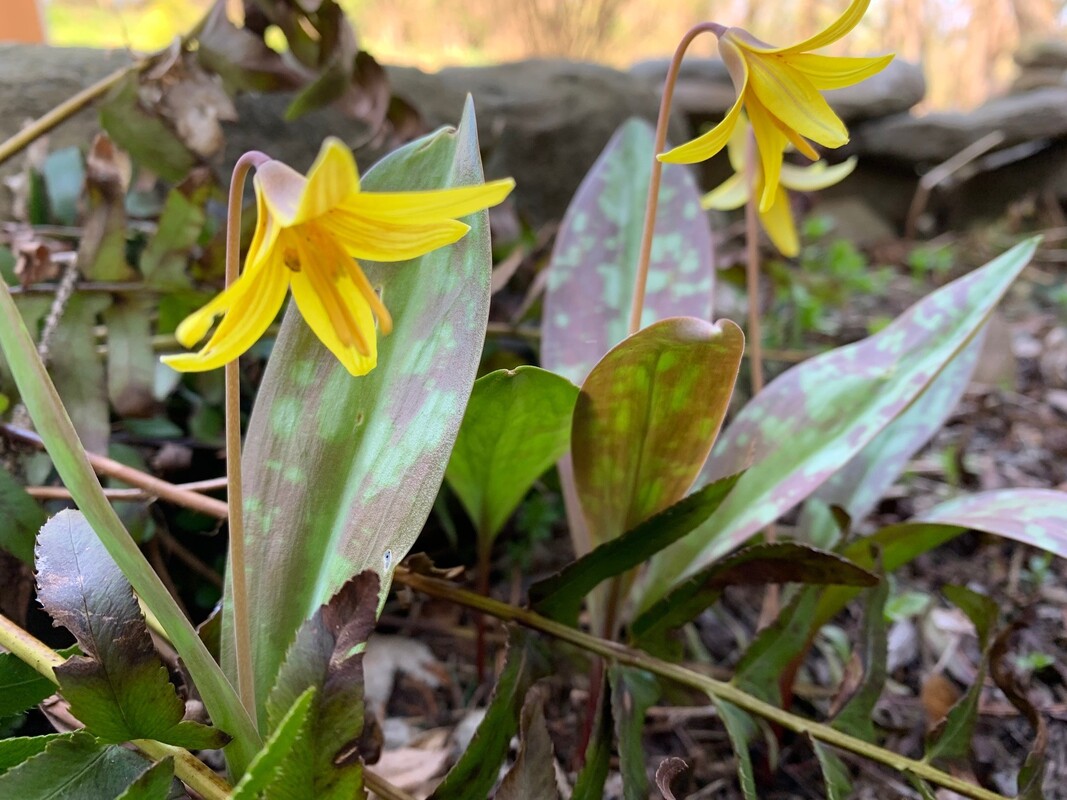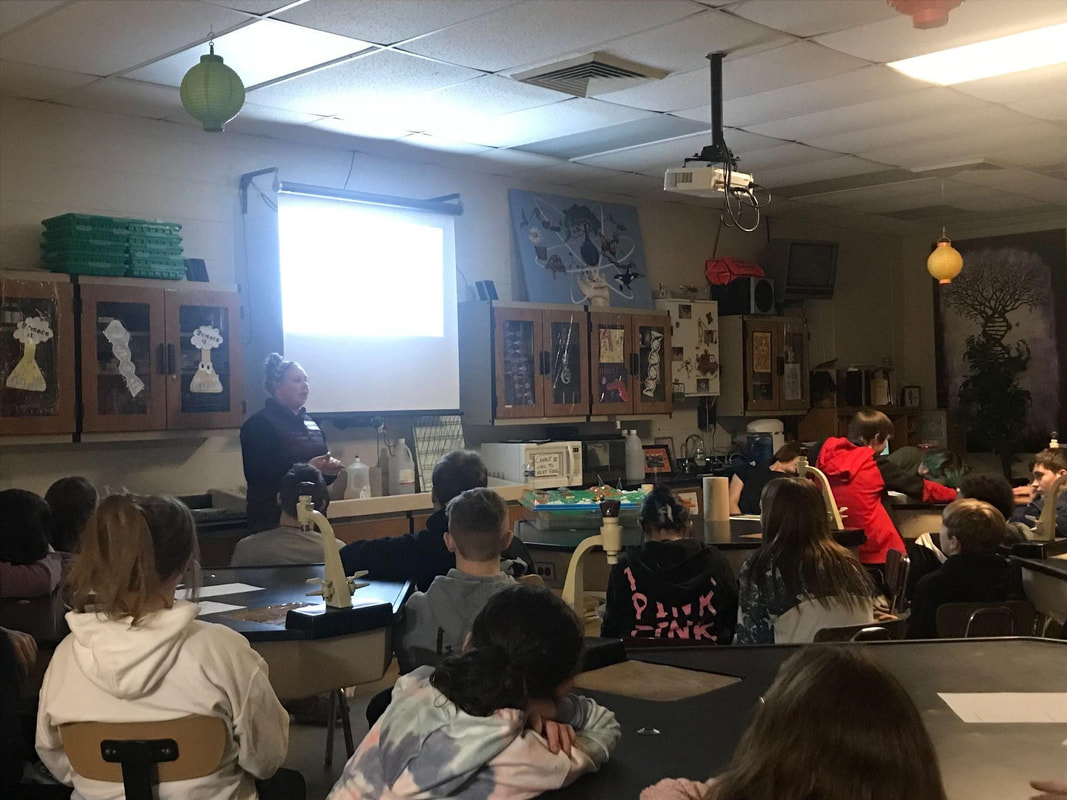|
By Jake Cochran, DGLVR Technician The Dirt, Gravel & Low Volume Road program is predicated on the concept of “local control." At the district level, this is achieved through the recommendations of the Quality Assurance Board (QAB). The QAB is a four-member “steering committee” that makes recommendations to the district board on project funding and local policies. This four-person body is comprised of a nonvoting chairman appointed by the conservation district directors, and one local representative appointed by each of the following entities: The federal Natural Resource Conservation Service, The Pennsylvania Fish and Boat Commission, and the county conservation district. The PFBC or NRCS may appoint members who are not necessarily a PFBC or NRCS employee to the QAB to serve as that agency’s representative. Local conservation agencies such as Trout Unlimited may be a potential source of QAB volunteers. These members assist the district with the establishment of local control and program requirements including but not limited to: fiscal, environmental, and written priorities, training incentives, and site inspections. The QAB’s recommendations are relayed to the conservation district board and action is taken on project approval and spending. The public is welcome to attend QAB meetings. The date, time, and location of these meetings are posted in advance on the district’s website and as a public notice in the local newspaper.
The Venango Dirt, Gravel & Low Volume Road Program QAB held a meeting on December 6, 2023 at 11:00 AM at the Venango Conservation District. The recommendations from this meeting were given to the Venango Conservation District's board of directors on December 14 at their monthly board meeting. The Venango Conservation District board of directors has approved funding for the following projects for the 2023-2024 DGLVR season: Dirt and Gravel Road Projects Canal Township – Wood Road - $95,877.00 Oakland Township – Gifford Road - $147,430.96 Pinegrove Township – Hale Road - $197,720.00 Irwin Township – Kerr Road - $80,000.00 Low Volume Road Projects Irwin Township - Whieldon Road - $23,700.00
1 Comment
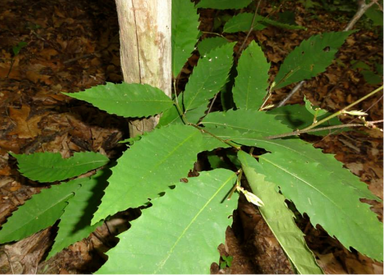 An American Chestnut stump sprout. The dead stem in the background succumbed to blight. The sprout will become infected with blight before it can begin to produce chestnuts. Source: Alliance for the Chesapeake Bay An American Chestnut stump sprout. The dead stem in the background succumbed to blight. The sprout will become infected with blight before it can begin to produce chestnuts. Source: Alliance for the Chesapeake Bay By Bailey Kozalla, Watershed Specialist Over a century ago, eastern hardwood forests looked very different than they do today. What once made up a quarter of deciduous tree species across its range has now been wiped away leaving little to no trace of its former existence. Now, the ghosts of over four billion individuals haunt our woods, and have since been a distant memory. The American Chestnut succumbed to a fungus known as chestnut blight or Cryphonectria parasitica. It was first discovered in 1904 at the Bronx Zoo and had since infected the chestnut’s entire range by 1950. The fungus forms cankers throughout the tree’s inner bark and eventually girdles the tree. Young American Chestnuts are often found stump-sprouting from ancestor trees, but they too will eventually die from the blight before they reach reproduction potential. The fungus resides in nearby oaks, which are notably unaffected. Despite these young chestnuts still being present in our forests, they are considered to be functionally extinct due to their inability to reproduce. As the chestnuts vanished, eastern forests were forever changed. The lumber industry lost a hallmark wood product that was known for its strong integrity and its ability to withstand weathering. In fact, many of the old fence posts seen on farm lands are made of chestnut wood. Additionally, many declining wildlife populations are attributed to the loss of the chestnut. The chestnut crop was a consistent annual food source for deer, squirrels, bears, turkeys, and others - unlike the oaks which only produce acorns every few years. Early 1900 reports document the steady decline of squirrel species, and several pollinator species who relied on the mid-summer bloom of chestnut flowers have declined or gone extinct. The present shrub-like chestnuts seen in the understory hardly resemble the ghosts of the “sequoias of the east” that dominated the landscape over one hundred years ago. There is hope, however, to see the return of chestnut trees to eastern forests. The American Chestnut Foundation began breeding blight-resistant trees with the naturally resistant Chinese Chestnut in 1989. This process continued over many years and resulted in a 94% American Chestnut and 6% Chinese Chestnut offspring. Doted the “Restoration Chestnut,” these trees are being experimentally planted throughout their historic range on federal, state, and private lands. Managers at the Allegheny National Forest are researching restoration techniques including site suitability, impacts of deer browsing, and the chestnut's response to prescribed fire. Research is still being done with regard to modern genetic modification in hopes to increase blight resistance even further. The regulatory process associated with reintroducing the blight-resistant chestnut will likely take many years, however. Despite the goal being to restore the tree to its native range, the chestnut will not likely be as dominant as it once was. This is due to the threat of invasive species and deer browsing which will make it difficult to encourage seedlings to become established naturally. This Halloween, remember that the ghost of the American Chestnut is a horror story of its own that haunts our eastern forests. Restoration efforts, however, are hoping that future generations of people, wildlife, and forests can enjoy the American Chestnut and the ecosystem services that it provides. Trout Unlimited’s Bullion Run Large Wood Addition Project Stream restoration staff from Trout Unlimited were busy carefully creating fish habitat and improving stream function on Bullion Run earlier this month. A tributary to Scrubgrass Creek in Clinton Township, Bullion Run is a designated cold water fishery that supports naturally reproducing trout populations. During the week of August 7, a large wood addition project aimed to improve habitat conditions for coldwater species resilience. A Growing Greener grant was awarded to Trout Unlimited in 2019 and was used to implement a streambank stabilization project at the mouth of Bullion Run. The remaining funds from this grant were used to support this large wood addition project. Also known as strategic wood addition, this “chop and drop” technique involves cutting trees of various sizes using chainsaws and felled into the stream, and are often mechanically moved using winches or heavy machinery to create different structure types. At the height of industrial logging in the nineteenth century, much of our forests including riparian cover were removed from the landscape. Streams were removed of material including fallen trees and boulders that could impact navigability primarily for the timber harvesting industry. These changes altered the stream’s flow velocity and channel patterns that often led to many ecological consequences that are still encountered today. Streambank erosion, entrenched channels, and the lack of complex habitat resulted from the removal of woody material from streams. Without the presence of pool features that downed trees create, streams are void of important spawning areas for coldwater fish species and its ability to absorb some of the harsh effects of flooding. By simulating natural recruitment of woody material, pools are able to form, banks are protected from erosion, and base flows become colder. A stream with a diverse pattern of features such as riffles, pools, and runs perform different functions for the aquatic plants and animals living in it. Macroinvertebrates including insects, crustaceans, and mussels rely on diverse habitat types for feeding, reproduction, and protection from predators. Sensitive fish species such as trout depend on high dissolved oxygen levels that cold water provides, as well as the availability of macroinvertebrates as an important food source. Many of these habitat requirements are addressed through the presence of wood additions, whether natural or human-induced, to streams. Large wood additions are a useful tool for creating habitat and improving stream function, but is not an all-encompassing solution for reintroducing wood in streams. In the long term, protection and reintroduction of riparian forests allows a natural process of woody debris recruitment to ensure a biologically diverse stream ecosystem that ensures environmental, recreational, and economic benefits. Further Reading: Penn State Extension: Benefits of Large Woody Debris in Streams, Trout Unlimited: A Beautiful Mess, The Freshwater Trust: Benefits of Large Wood Structures in Rivers 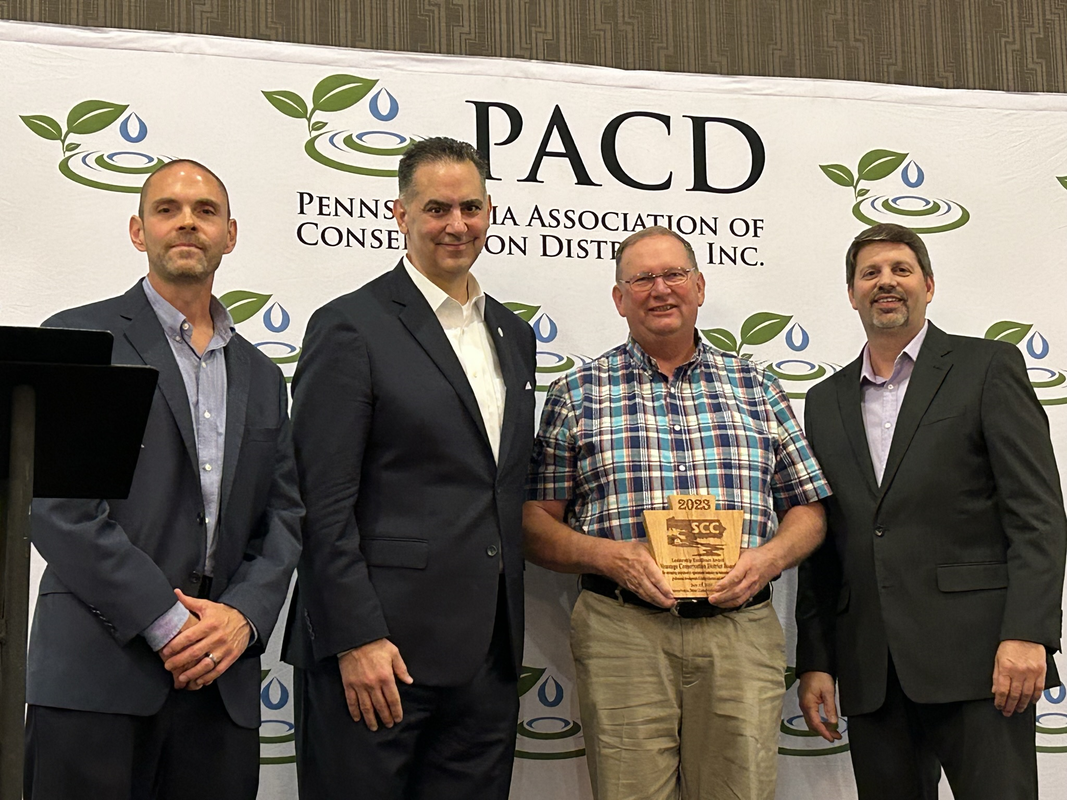 L to R: Doug Wolfgang, Executive Secretary State Conservation Commission, Richard Negrin, Secretary PA Department of Environmental Protection, Mike Ohler, Venango Conservation District Board of Directors Chairman, Gregory Hostetter, Executive Deputy Secretary PA Department of Agriculture On July 19th, 2023, the Venango Conservation District Board of Directors was honored to receive the State Conservation Commission’s Leadership Excellence Award. The award is presented annually to a conservation district board that provides a well-articulated, relevant and implemented mission addressing natural resource challenges and opportunities within the county, demonstrates exemplary leadership and service to the community, continuously supports and evaluates professional management and leadership and demonstrates a commitment to excellence in effective management, accountability, oversight and stewardship of the conservation district. Doug Wolfgang, Executive Secretary of the State Conservation Commission commended the Venango Conservation District Board of Directors on their hard work through a challenging year, leading the district through the sudden passing of District Manager Lance Bowes, while at the same time managing open positions of more than half of district staff. Accepting the award on behalf of the Venango Conservation District Board of Directors was Mike Ohler, Chairman of the Board. Mike said about leading through this challenging year that he could not say enough about how well the board responds to challenges, how well board committees work together and how active members are at meetings. He added that a good conservation district is also a response created by a good staff. Welcome, Abigail Zerbe, our new Administrative Secretary!  Hi, my name is Abigail Zerbe! I am the new Administrative Secretary at the Venango Conservation District. I grew up outside of Emlenton and now live in Knox. I graduated from Clarion University in the spring of 2021 with my bachelor’s degree, double majoring in Geology and Environmental Geoscience with a concentration in Mineral Resource Exploration. During college, I interned with the Jefferson County History Center, installing their award-winning “Stones and Bones” exhibit, and I served as Geoscience Club treasurer for two semesters and president for one semester. I received my Professional Bookkeeper, Professional Tax Preparer, and QuickBooks Specialist certifications from Universal Accounting School in 2022. I consider myself perpetually curious; thus, I have a lot of hobbies. My favorite indoor pastimes include crocheting, printmaking, quilting, and aquarium keeping. Of course, I love spending time outdoors, from fly fishing or kayaking on the water to hiking in the woods. June 15, 2023 By: Brenda Shambaugh, Executive Director of the Pennsylvania Association of Conservation Districts [email protected] | 717-794-6103 Did you know that over one-quarter of all the land in Pennsylvania is farmland? Of the 52,700 farms on this land, 88% are small producers making under $250,000 in gross revenue each year.
Many farmers rely on federal Farm Bill conservation programs to adopt conservation practices. Congress will soon consider a 2023 Farm Bill which could provide a unique opportunity to focus resources on farms in Pennsylvania helping ensure enough clean water for future generations, reduce pollution, bolster them to weather the changes brought by climate change, and keep them operating with a profit. The Pennsylvania Association of Conservation Districts (PACD), representing all 66 conservation districts in the Commonwealth, strongly supports funding for state and federal conservation programs. Conservation districts are local units of government providing a wide range of services for the conservation of the Commonwealth’s natural resources. Districts implement programs, projects, and activities working with landowners, local governments, and a variety of partners to provide technical and financial assistance. These natural resource programs supported by PACD provide almost $46 million to Pennsylvania’s producers to implement environmentally beneficial best management practices (BMPs) on their farms. Combined, these programs included 733 contracts with Pennsylvania farmers, encompassing 155,658 acres. The 2023 Farm Bill should increase funding for these effective programs responding to a growing demand and helping ensure success of resource protection efforts. The key to success involves highly trained field staff to ensure that tools and incentives are efficiently used to target the most effective practices in the most effective locations, accelerating restoration progress. Funding for technical assistance personnel at the local level through conservation districts is vital to preserve both surface and groundwater resources. While 28% of Pennsylvania is farmland, over 58% is forest lands totaling 16.8 million acres. Non-industrial private forest lands cover about 11.5 million acres in Pennsylvania which is owned and operated by more than 738,000 private forest landowners. Forest Buffers and streamside trees are one of the most cost-effective BMPs for reducing pollution to Pennsylvania’s rivers and streams, while also providing benefits to wildlife, sequestering carbon, and making streams resilient to weather extremes of flooding and drought. Through financial and technical assistance, and in coordination with partners, PA is making significant steps toward a goal of maintaining and improving the health and resiliency of forested ecosystems on private forest lands. We highly recommend funding in the 2023 Farm Bill to address the health and resiliency of Pennsylvania’s forests. The Conservation Reserve Enhancement Program (CREP) is another program geared toward providing incentives to restore and improve Pennsylvania’s water quality. It is a voluntary federal-state partnership allowing landowners to remove marginal land from agricultural production under 10-15 year contracts. In return, landowners receive annual rental, incentive, maintenance and cost-share payments. Legislative changes in the 2023 Farm Bill removing barriers to enrollment and allowing states to easily take advantage of program improvements and incentives for landowners will help re-invigorate this critical opportunity to enhance the CREP program. Please join PACD to support increased funding for these federal programs in the 2023 Farm Bill that benefit small family farms and landowners, and cleaner rivers and streams, and contact your United States Representatives and two United States Senators as they deliberate this critical piece of legislation. Thank you. Brenda J. Shambaugh is Executive Director for the Pennsylvania Association of Conservation Districts, Inc. (PACD). As PACD's Executive Director, Brenda represents the 66 Pennsylvania conservation districts at the state and national level. In addition to being the organization’s spokesperson, she manages all operations of the PACD office and is responsible for the organization’s financial management. She also develops and implements the association’s government relations strategy. The Pennsylvania Association of Conservation Districts, Inc. (PACD) is a non-profit organization whose guiding values include: Sustainable Resource Conservation; Integrity, Local; Education and Outreach; and Partnerships. PACD primarily serves as the collective voice for Pennsylvania’s 66 county conservation districts. For more information about PACD, visit www.pacd.org. Students from Venango County schools tested their knowledge in natural resources during the 2023 Venango County Envirothon competition held at Two Mile Run County Park on April 21. About 35 students from Cranberry, Oil City, and Rocky Grove high schools attended this year’s event. Students competed as part of a five-member team, with seven teams participating. Three teams represented Cranberry, while Oil City and Rocky Grove sent two teams each. This annual environmental education event focuses on exposing young adults to various natural resource topics that are taught by their teachers and local environmental professionals. They study forestry, aquatic ecology, wildlife, soils and land use, and a current environmental issue. This year’s current issue topic was “Adapting to a Changing Climate.” Hosted by the Venango Conservation District, the competition was accompanied by an “Envirothon Training Day” which was held at Two Mile Run County Park on March 24. Students were presented with information about each topic by local agency representatives including the PA Fish & Boat Commission, PA Department of Conservation and Natural Resources, and the Natural Resources Conservation Service. On testing day, the students rotated between stations which tested their knowledge on wildlife identification, aquatic macroinvertebrate classification, forest management techniques, among others. One of the Cranberry High School teams advised by Lauri Piercy, took home the first-place title. Named the “Tunnel Rats,” the team consisted of students Dalton Wenner, Colin Zerbe, Dane Ley, Dan Wenner, and Kelsey Hannah. Also from Cranberry, the “Hellbenders” team took second place, and the “Predators” team from Oil City High School finished third. The “Tunnel Rats” will travel to Camp Mount Luther in Mifflinburg, PA on May 24 to represent Venango County in the 40th annual state Envirothon competition. The “Tunnel Rats” team from Cranberry High School placed first overall at the Venango County Envirothon competition at Two Mile Run County Park on April 21. They will be representing Venango County at the state Envirothon competition on May 24 in Mifflinburg, PA. Pictured left to right: Dalton Wenner (9th grade), Colin Zerbe (12th grade), Dane Ley (12th grade), Dan Wenner (10th grade), and Kelsey Hannah (10th grade).
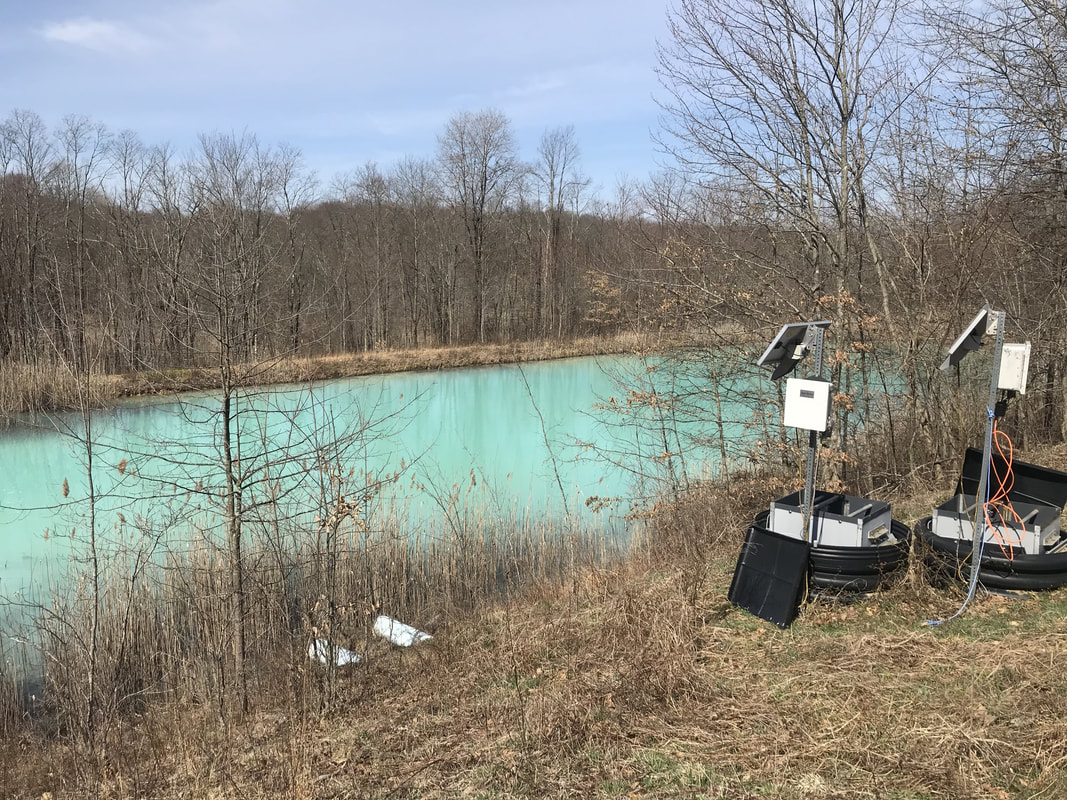 The Venango Conservation District offers support to watershed organizations throughout Venango County. One of those organizations, the Scrubgrass Creek Watershed Association (SCWA), conducts monthly water quality testing at two acid mine drainage treatment systems within the Scrubgrass creek watershed. Our Watershed Specialist, Bailey Kozalla, assisted two members of the SCWA on Tuesday, April 11 during their testing of pH levels, total alkalinity, and flow rates of water coming in and flowing out of the treatment systems. Conducting these tests monthly allows the SCWA to monitor the systems' effectiveness in neutralizing water acidity. To learn more about acid mine drainage and treatment systems, visit the PA Department of Environmental Protection's website: https://www.dep.pa.gov/OurCommonWealth/pages/Article.aspx?post=92 Early Bloomers: Get to know Spring Ephemerals By Bailey Kozalla, Venango Conservation District4/11/2023 Birds chirping, trees budding, and peepers peeping - the spring season is officially upon us! As we begin to enjoy the warmer weather and sunshine, the signs of the new season are all around us. The plants and wildflowers that begin to emerge after winter are called spring ephemerals. While the seasonal lifespan of these perennials is short-lived, they are important to the health of the ecosystem. These woodland wildflowers will begin to emerge from their dormant stage as the daylight hours begin to prolong at the beginning of spring. As the soil temperature increases, they will start growing stems, leaves, and flowers. The growing strategy of these plants allows them to take advantage of sunlight availability during this time of year. In deciduous forests, leaves have not yet grown on trees which permits sunlight to reach the forest floor in a much higher surface area. The spring ephemerals are able to use this sunlight to conduct photosynthesis and complete their cycle of blooming, pollination, and setting seed before the overstory trees shade the forest with their foliage in the summer. How to Grow Spring Ephemerals These plants are a great way to include early-blooming landscaping on your property. Plant them near an area with deciduous trees in moist soil (areas that receive sun in the spring, but are shaded in the summer). The fallen leaves of deciduous trees ensure an even ground temperature in the winter and keeps the soil rich and moist for ephemeral plants. Grow them under this leaf litter, which provides the environment needed for them and their pollinators. Planting them in the fall or early winter is ideal. Since they would be dormant during this time, however, you would be planting only the root or bulb of the plant. Ephemerals can be planted in the spring, but they may not flower during its first season. Spring ephemerals currently established in the wild should not be removed as they serve as an important food source for wildlife emerging from hibernation and for pollinators. The sensitive nature of these plant species also do not fare well being transplanted. It is best to purchase them from a nursery or online through a native plant mail order company. Types of Spring Ephemerals Here are a few species of spring ephemerals that you may see on your own property or on your next hike in and around Venango county. Photos and descriptions of these species are adapted from the Western Pennsylvania Conservancy’s website. To view descriptions of these spring ephemerals and others, visit their website here: https://waterlandlife.org/spring-wildflowers/ Snow Trillium (Trillium nivale) This member of the lily family is found only on the western side of Pennsylvania. Only growing to 15 centimeters tall, this plant grows fleshy structures called fatty elaiosomes which attract ants to disperse its seeds. Squirrel-corn (Dicentra canadensis) This plant begins to bloom in mid April and goes to fruit by mid May. By the time the fruit ripens, the leaves are yellow and are resting on the ground. They can be exposed to natural erosion due to their preferred habitat being rocky, mountainous slopes. Yellow trout lily (Erythronium americanum)
You can find large colonies of this bright yellow flower covering the forest floor. The plant gets its name from its mottled leaf markings that resemble a brown or brook trout (and they bloom during trout fishing season!). It can take up to five years for the plant to start producing a flower. The plants reproduce with both runners and seeds, and like the trillium, ants help to propagate the seeds. On February 17, 2023, the district’s Agricultural Technician Jane Price and Watershed Specialist Bailey Kozalla visited Cranberry High School to teach students about the role Conservation Districts play in cooperating with farmers to implement environmental Best Management Practices (BMPs). By presenting a mock farming scenario, the students identified livestock heavy use areas, environmentally sensitive areas, and calculated Animal Equivalent Units (AEU) on the farm. Using these characteristics, the students learned about implementing agricultural BMPs and compiling manure management plans for farming operations. Approximately 140 seventh and ninth grade students attended the presentation throughout the school day. The district offers technical assistance to farmers throughout Venango county to implement Best Management Practices. Agricultural BMPs work to reduce soil, fertilizer, and animal nutrient runoff into our waterways. This not only ensures the conservation of our soil and water resources, but also improves the productivity of the land and reduces operational costs on the farm. Interested in bringing an environmental education program to your school or organization? Contact the Venango Conservation District at (814) 676-2832 or send an email to Bailey Kozalla at [email protected]. Venango Conservation District welcomes new Watershed Specialist02/22/2023
Hello, my name is Bailey Kozalla and I am the new Watershed Specialist for the Venango Conservation District. I am a Crawford County native, graduating from Saegertown High School in 2018. I received my B.S. degree in Environmental Science with a minor in Environmental Writing from Allegheny College in May of 2022. Before joining the Venango Conservation District, I gained experience working for federal, state, and non-profit conservation organizations such as the U.S. Fish & Wildlife Service, the Pennsylvania Game Commission, and the Foundation for Sustainable Forests. Throughout college and my prior work experience, my passion for conservation grew as I developed my skills conducting education and outreach, mapping projects (GIS), habitat enhancement, and writing articles for various publications. I am an avid outdoorswoman, as I love to go hunting and fishing in my spare time. These hobbies have taken me throughout the many woods and waters of Northwestern Pennsylvania. I am excited to be a member of the district team and contribute to natural resource management throughout Venango County. |
CATEGORIESs
All
Archives
July 2024
|
